Calcined Clays as Concrete Additive in Structural Concrete: Workability, Mechanical Properties, Durability, and Sustainability Performance
Abstract
:1. Introduction
2. Materials and Methods
2.1. Raw Materials
2.2. Concrete Mix Design
2.3. Test Methods
3. Experimental Results
3.1. Fresh Concrete Properties
3.2. Compressive Strength
3.3. Carbonation Resistance
3.4. Chloride Migration Resistance
3.5. Freeze–Thaw Resistance
3.6. Sustainability Assessment
4. Conclusions
- The decrease in workability resulting from the CC addition to the concrete composition can be compensated by adjusting the superplasticizer dosage.
- The bleeding tendency of the concretes is reduced with increasing CC dosage, even at high superplasticizer dosages.
- The air void content and bulk density of fresh concrete are not significantly affected.
- The early age strength is decreased for CC concretes, but the final strength after 28 days is improved for CC dosages up to 30 wt% (C70-CC30) compared to the pure OPC system (C100-CC0).
- The resistance against carbonation is generally reduced with increasing CC content, even though a carbonation resistance equivalent to that of OPC was found for a mix with 15 wt% CC.
- Internal damage due to freeze–thaw cycles is increased, so the exposure of the structural concrete element must be taken into account.
- The chloride migration resistance is strongly improved with increasing CC dosage due to the reduced porosity and denser microstructure.
- The GWP values of the concrete investigated are comparable to those of concretes with high blended cements.
Author Contributions
Funding
Institutional Review Board Statement
Informed Consent Statement
Data Availability Statement
Acknowledgments
Conflicts of Interest
References
- Lothenbach, B.; Scrivener, K.; Hooton, R.D. Supplementary cementitious materials. Cem. Concr. Res. 2011, 41, 1244–1256. [Google Scholar] [CrossRef]
- Palm, S.; Müller, C.; Proske, T.; Rezvani, M.; Graubner, C.A. Concrete application of clinker-efficient cements. Adv. Cem. Res. 2019, 31, 225–234. [Google Scholar] [CrossRef]
- Müller, C.; Palm, S.; Hermerschmidt, W. Durability properties of concretes using CEM II/C-M (S-LL) and CEM II/B-LL cements. Cem. Int. 2020, 18, 52–62. [Google Scholar]
- Proske, T.; Rezvani, M.; Palm, S.; Müller, C.; Graubner, C.-A. Concretes made of efficient multi-composite cements with slag and limestone. Cem. Concr. Compos. 2018, 89, 107–119. [Google Scholar] [CrossRef]
- Palm, S.; Proske, T.; Rezvani, M.; Hainer, S.; Müller, C.; Graubner, C.-A. Cements with a high limestone content—Mechanical properties, durability and ecological characteristics of the concrete. Constr. Build. Mater. 2016, 119, 308–318. [Google Scholar] [CrossRef]
- Scrivener, K.; Martirena, F.; Bishnoi, S.; Maity, S. Calcined clay limestone cements (LC3). Cem. Concr. Res. 2018, 114, 49–56. [Google Scholar] [CrossRef]
- Antoni, M.; Rossen, J.; Martirena, F.; Scrivener, K. Cement substitution by a combination of metakaolin and limestone. Cem. Concr. Res. 2012, 42, 1579–1589. [Google Scholar] [CrossRef]
- Trümer, A. Calcinierte Tone als Puzzolane der Zukunft—Von den Rohstoffen bis zur Wirkung im Beton. Ph.D. Thesis, Bauhaus Universität Weimar, Weimar, Germany, 2020. [Google Scholar]
- Beuntner, N. Zur Eignung und Wirkungsweise Calcinierter Tone als Reaktive Bindemittelkomponente im Zement. Ph.D. Thesis, Universität der Bundeswehr München, Neubiberg, Germany, 2017. [Google Scholar]
- Hanein, T.; Thienel, K.-C.; Zunino, F.; Marsh, A.T.M.; Maier, M.; Wang, B.; Canut, M.; Juenger, M.C.G.; Ben Haha, M.; Avet, F.; et al. Clay calcination technology: State-of-the-art review by the RILEM TC 282-CCL. Mater. Struct. 2022, 55, 3. [Google Scholar] [CrossRef]
- He, C.; Osbaeck, B.; Makovicky, E. Pozzolanic reactions of six principal clay minerals: Activation, reactivity assessments and technological effects. Cem. Concr. Res. 1995, 25, 1691–1702. [Google Scholar] [CrossRef]
- Li, R.; Lei, L.; Sui, T.; Plank, J. Effectiveness of PCE superplasticizers in calcined clay blended cements. Cem. Concr. Res. 2021, 141, 106334. [Google Scholar] [CrossRef]
- Bai, J.; Wild, S.; Sabir, B.B.; Kinuthia, J.M. Workability of concrete incorporating pulverized fuel ash and metakaolin. Mag. Concr. Res. 1999, 51, 207–216. [Google Scholar] [CrossRef]
- Ferreiro, S.; Herfort, D.; Damtoft, J.S. Effect of raw clay type, fineness, water-to-cement ratio and fly ash addition on workability and strength performance of calcined clay—Limestone Portland cements. Cem. Concr. Res. 2017, 101, 1–12. [Google Scholar] [CrossRef]
- Alujas, A.; Fernández, R.; Quintana, R.; Scrivener, K.L.; Martirena, F. Pozzolanic reactivity of low grade kaolinitic clays: Influence of calcination temperature and impact of calcination products on OPC hydration. Appl. Clay Sci. 2015, 108, 94–101. [Google Scholar] [CrossRef]
- Thienel, K.-C.; Scherb, S.; Beuntner, N.; Maier, M.; Sposito, R. 1:1 or 2:1—Does it matter for calcined clay as supplementary cementitious material? ce/papers 2023, 6, 363–372. [Google Scholar] [CrossRef]
- Hosseinzadeh Zaribaf, B. Metakaolin-Portland Limestone Cements: Evaluating the Effects of Chemical Admixtures on Early and Late Age Behavior. Ph.D. Thesis, Georgia Institute of Technology, Atlanta, GA, USA, 2018. [Google Scholar]
- Deiters, M.; Rozanski, C.; Schack, T.; Haist, M. Influence of calcined clay on micromechanical properties and creep of hardened cement paste. ce/papers 2023, 6, 431–440. [Google Scholar] [CrossRef]
- Qian, Y.; De Schutter, G. Enhancing thixotropy of fresh cement pastes with nanoclay in presence of polycarboxylate ether superplasticizer (PCE). Cem. Concr. Res. 2018, 111, 15–22. [Google Scholar] [CrossRef]
- Sposito, R.; Maier, M.; Beuntner, N.; Thienel, K.-C. Physical and mineralogical properties of calcined common clays as SCM and their impact on flow resistance and demand for superplasticizer. Cem. Concr. Res. 2022, 154, 106743. [Google Scholar] [CrossRef]
- Lei, L.; Palacios, M.; Plank, J.; Jeknavorian, A.A. Interaction between polycarboxylate superplasticizers and non-calcined clays and calcined clays: A review. Cem. Concr. Res. 2022, 154, 106717. [Google Scholar] [CrossRef]
- Sposito, R.; Beuntner, N.; Thienel, K.-C. Characteristics of components in calcined clays and their influence on the efficiency of superplasticizers. Cem. Concr. Compos. 2020, 110, 103594. [Google Scholar] [CrossRef]
- Thienel, K.-C.; Beuntner, N. Effects of CC as Low Carbon Cementing Materials on the Properties of Concrete. In Concrete in the Low Carbon Era, Proceedings of the International Conference Held at the University of Dundee, Dundee, UK, 9–11 July 2012; Jones, M.R., Newlands, M.D., Halliday, J.E., Csetenyi, L.J., Zheng, L., Eds.; University of the German Federal Army: Munich, Germany, 2012; pp. 504–517. [Google Scholar]
- Muzenda, T.R.; Hou, P.; Kawashima, S.; Sui, T.; Cheng, X. The role of limestone and calcined clay on the rheological properties of LC3. Cem. Concr. Compos. 2020, 107, 103516. [Google Scholar] [CrossRef]
- Vance, K.; Kumar, A.; Sant, G.; Neithalath, N. The rheological properties of ternary binders containing Portland cement, limestone, and metakaolin or fly ash. Cem. Concr. Res. 2013, 52, 196–207. [Google Scholar] [CrossRef]
- Huang, H.; Li, X.; Avet, F.; Hanpongpun, W.; Scrivener, K. Strength-promoting mechanism of alkanolamines on limestone-calcined clay cement and the role of sulfate. Cem. Concr. Res. 2021, 147, 106527. [Google Scholar] [CrossRef]
- Sabir, B.; Wild, S.; Bai, J. Metakaolin and calcined clays as pozzolans for concrete: A review. Cem. Concr. Compos. 2001, 23, 441–454. [Google Scholar] [CrossRef]
- Cordoba, G.; Sposito, R.; Köberl, M.; Zito, S.; Beuntner, N.; Tironi, A.; Thienel, K.-C.; Irassar, E.F. Chloride migration and long-term natural carbonation on concretes with calcined clays: A study of calcined clays in Argentina. Case Stud. Constr. Mater. 2022, 17, e01190. [Google Scholar] [CrossRef]
- Trümer, A.; Ludwig, H.-M. Assessment of CCs According to the Main Criterions of Concrete Durability; Springer: Dordrecht, The Netherlands, 2018; pp. 475–481. [Google Scholar] [CrossRef]
- Khan, M.S.H.; Nguyen, Q.D.; Castel, A. Carbonation of Limestone CC Cement Concrete; Springer: Dordrecht, The Netherlands, 2018; pp. 238–243. [Google Scholar] [CrossRef]
- Dhandapani, Y.; Joseph, S.; Geddes, D.A.; Zhao, Z.; Boustingorry, P.; Bishnoi, S.; Vieira, M.; Martirena, F.; Castel, A.; Kanavaris, F.; et al. Fresh properties of concrete containing calcined clays: A review by RILEM TC-282 CCL. Mater. Struct. 2022, 55, 151. [Google Scholar] [CrossRef]
- Sharma, M.; Bishnoi, S.; Martirena, F.; Scrivener, K. Limestone calcined clay cement and concrete: A state-of-the-art review. Cem. Concr. Res. 2021, 149, 106564. [Google Scholar] [CrossRef]
- Maraghechi, H.; Avet, F.; Wong, H.; Kamyab, H.; Scrivener, K. Performance of Limestone Calcined Clay Cement (LC3) with various kaolinite contents with respect to chloride transport. Mater. Struct. 2018, 51, 125. [Google Scholar] [CrossRef]
- Liao, Y.; Lv, Y.; Huang, G.; Ren, S.; Wang, X.-Y.; Guo, R.; Tian, Y.; Deng, S.; Lin, R.-S. Strength and microstructure analysis of subgrade materials containing red sandstone-limestone-cement composites and red sandstone gravel. Constr. Build. Mater. 2024, 416, 135190. [Google Scholar] [CrossRef]
- Beutner, N.; Thienel, K.-C. Pozzolanic efficiency of calcined clays in blended cements with focus on the early hydration. Adv. Cem. Res. 2022, 34, 341–355. [Google Scholar] [CrossRef]
- Sowoidnich, T.; Hoffmann, C.; Rößler, C.; Ludwig, H. Reaktivitätsuntersuchungen von calcinierten Tonen mit geringem Metakaolingehalt. ce/papers 2023, 6, 400–404. [Google Scholar] [CrossRef]
- Pott, U.; Crasselt, C.; Fobbe, N.; Haist, M.; Heinemann, M.; Hellmann, S.; Ivanov, D.; Jakob, C.; Jansen, D.; Lei, L.; et al. Characterization data of reference materials used for phase II of the priority program DFG SPP 2005 “Opus Fluidum Futurum—Rheology of reactive, multiscale, multiphase construction materials”. Data Brief 2023, 47, 108902. [Google Scholar] [CrossRef] [PubMed]
- DIN EN 1992-1-1:2011-01; Eurocode 2: Bemessung und Konstruktion von Stahlbeton—Und Spannbetontragwerken—Teil 1-1: Allgemeine Bemessungsregeln und Regeln für den Hochbau. Beuth: Berlin, Germany, 2011.
- DIN 1045-2:2023-08; Tragwerke aus Beton, Stahlbeton und Spannbeton—Teil 2: Beton. Beuth: Berlin, Germany, 2023.
- DIN EN 12350-5:2019-09; Prüfung von Frischbeton—Teil 5: Ausbreitmaß. Beuth: Berlin, Germany, 2019.
- DIN EN 12350-7:2022-05; Prüfung von Frischbeton—Teil 7: Luftgehalt—Druckverfahren. Beuth: Berlin, Germany, 2022.
- DIN EN 12350-6:2019-09; Prüfung von Frischbeton—Teil 6: Frischbetonrohdichte. Beuth: Berlin, Germany, 2019.
- Deutscher Beton- und Bautechnik-Verein, E.V. (Ed.) Merkblatt—Besondere Verfahren zur Prüfung von Frischbeton; Beuth: Berlin, Germany, 2014. [Google Scholar]
- DIN EN 12390-3:2019-10; Prüfung von Festbeton—Teil 3: Druckfestigkeit von Probekörpern. Beuth: Berlin, Gemany, 2019.
- DIN EN 12390-12:2020-04; Prüfung von Festbeton—Teil 12: Bestimmung des Karbonatisierungswiderstandes von Beton—Beschleunigtes Karbonatisierungsverfahren. Beuth: Berlin, Germany, 2020.
- Bundesanstalt für Wasserbau (Ed.) BAWMerkblatt Chlorideindringwiderstand von Beton (MCL); Bundesanstalt für Wasserbau (BAW-Merkblätter, -Empfehlungen und -Richtlinien): Karlsruhe, Germany, 2012. [Google Scholar]
- Bundesanstalt für Wasserbau (Ed.) BAWMerkblatt Frostprüfung von Beton (MFB); Bundesanstalt für Wasserbau (BAW-Merkblätter, -Empfehlungen und -Richtlinien): Karlsruhe, Germany, 2012. [Google Scholar]
- de Hita, M.J.; Criado, M. Influence of superplasticizers on the workability and mechanical development of binary and ternary blended cement and alkali-activated cement. Constr. Build. Mater. 2023, 366, 130272. [Google Scholar] [CrossRef]
- Haist, M.; Bergmeister, K.; Curbach, M.; Forman, P.; Gaganelis, G.; Gerlach, J.; Mark, P.; Moffat, J.; Müller, C.; Müller, H.S.; et al. Nachhaltig konstruieren und bauen mit Beton. In Beton-Kalender 2022; Bergmeister, K., Fingerloos, F., Wörner, J.-D., Eds.; Ernst & Sohn: Berlin, Germany, 2022; pp. 421–531. [Google Scholar]
- Damineli, B.L.; Kemeid, F.M.; Aguiar, P.S.; John, V.M. Measuring the eco-efficiency of cement use. Cem. Concr. Compos. 2010, 32, 555–562. [Google Scholar] [CrossRef]
- Wiens, U. Nachhaltig bauen mit Beton—Planungshilfe des Deutschen Ausschusses für Stahlbeton (DAfStb). Beton-Stahlbetonbau 2022, 117, 58–65. [Google Scholar] [CrossRef]

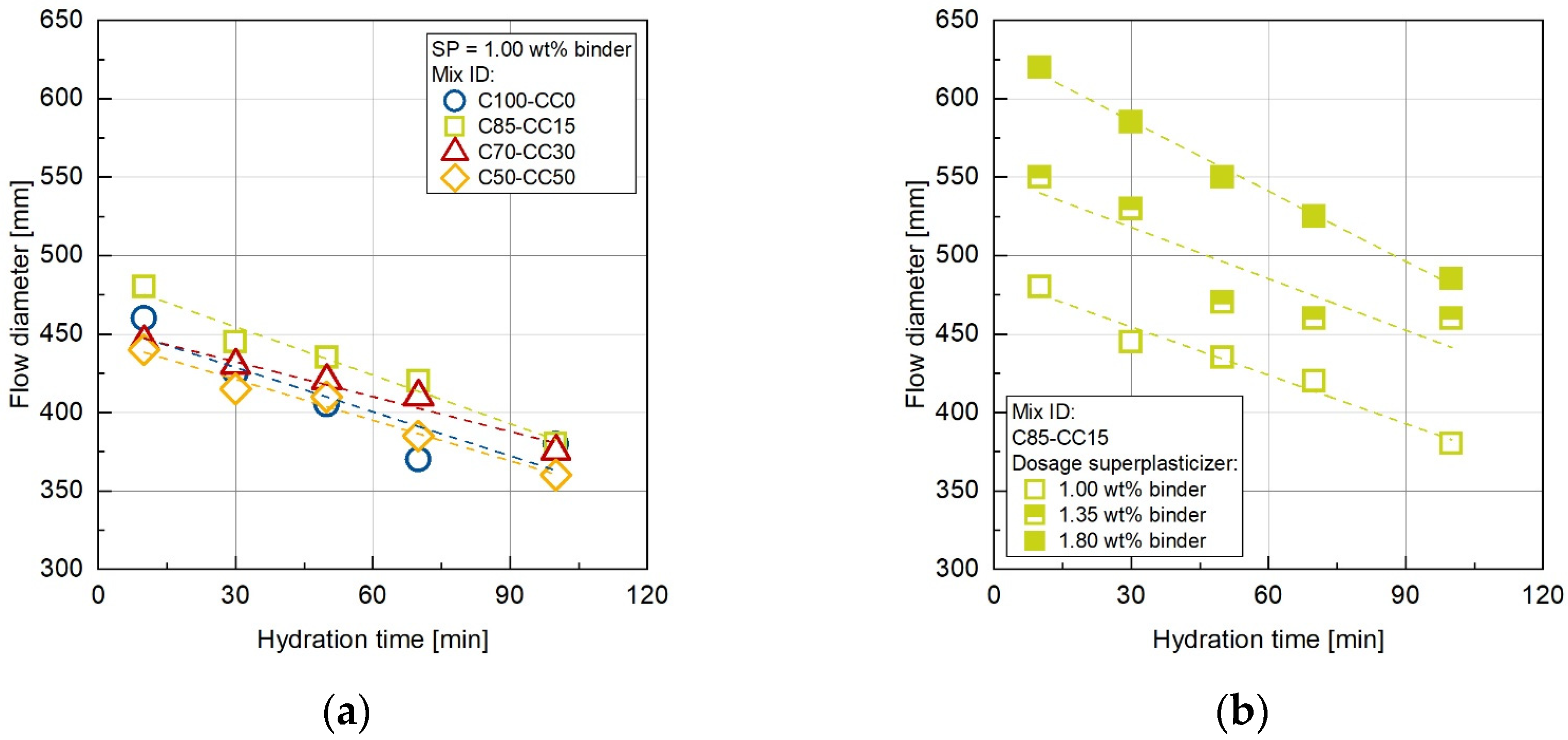

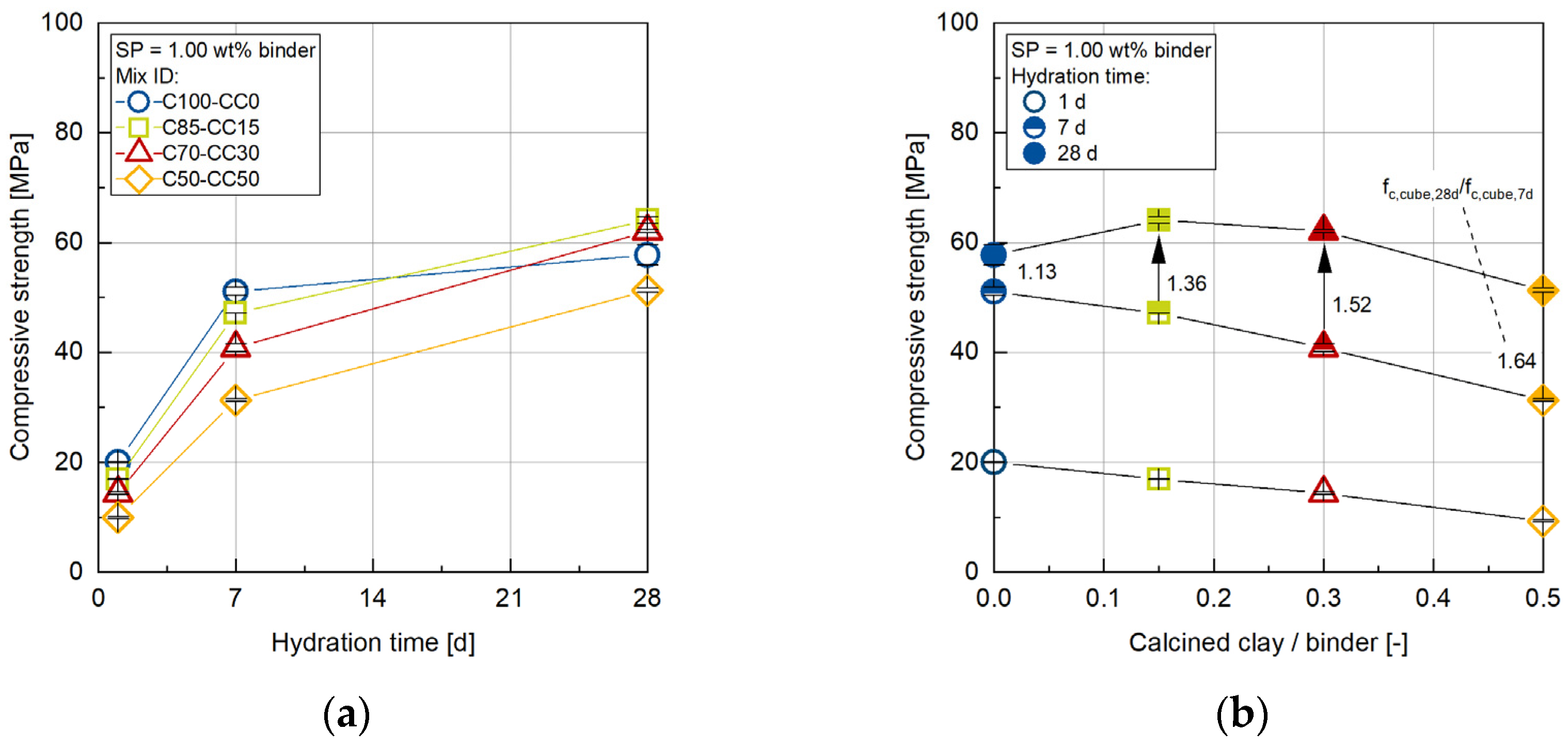
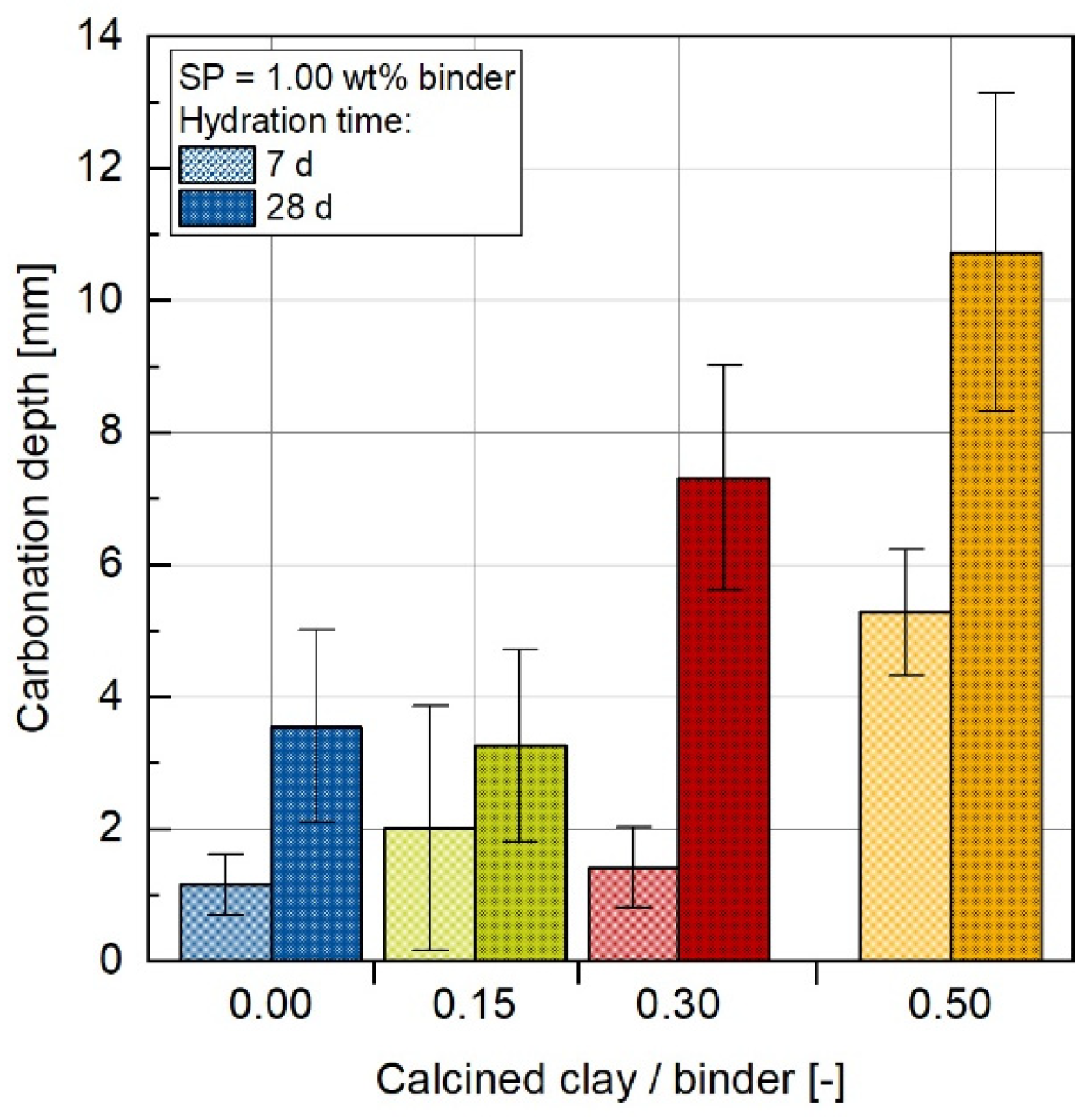
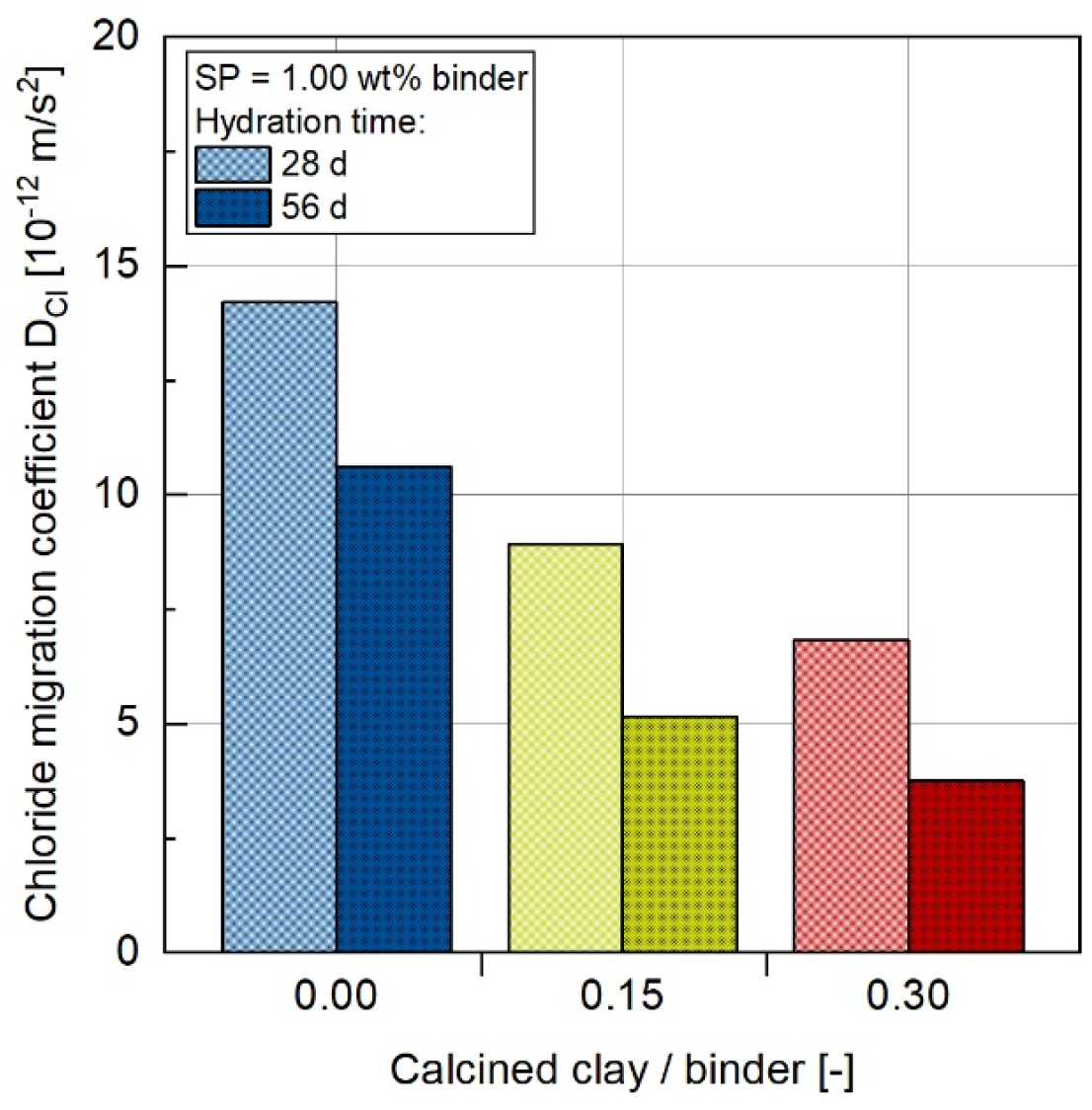
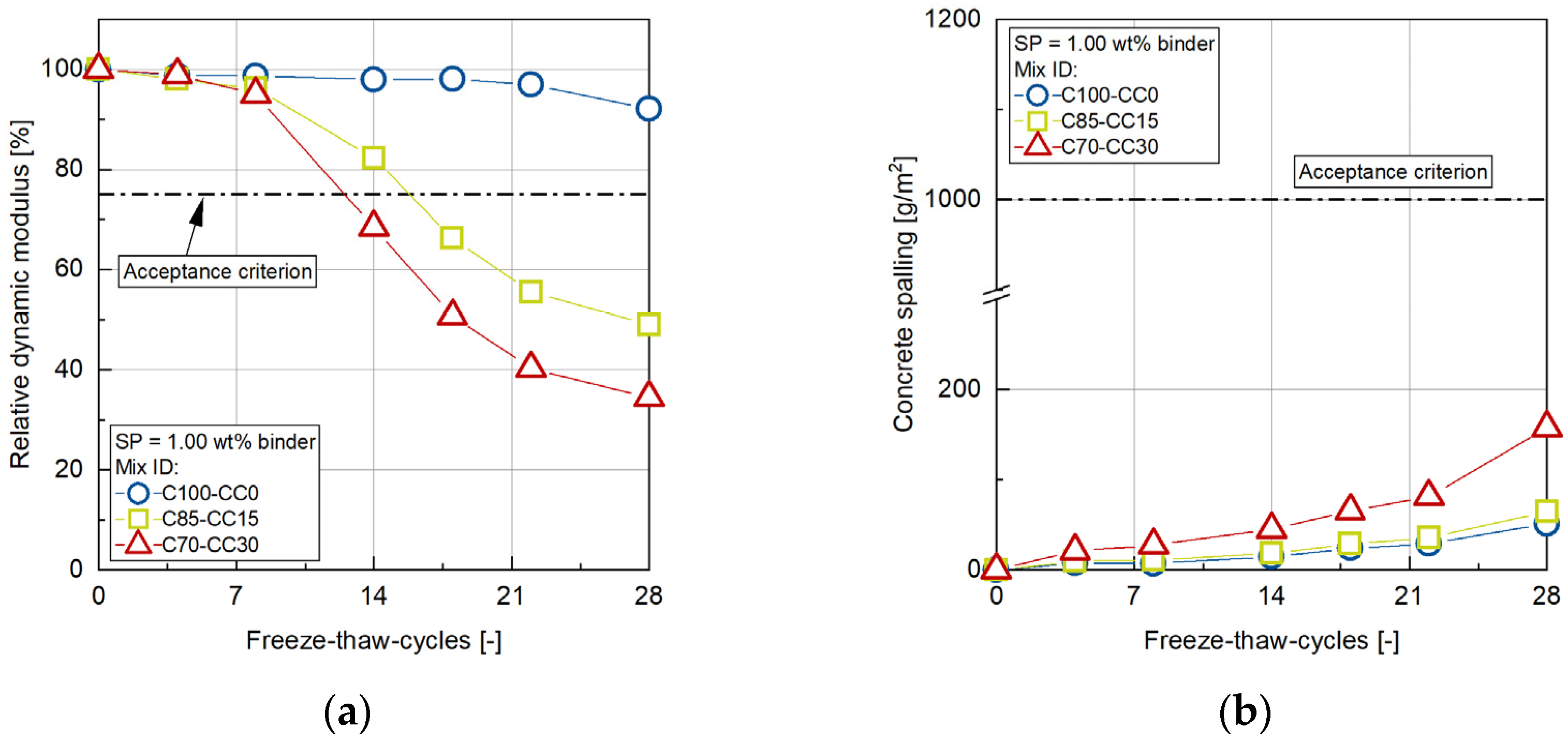

| Component | Density | Specific Surface Area (Blaine Method) | Specific Surface Area (BET Method) | Particle Size | ||
|---|---|---|---|---|---|---|
| d10 | d50 | d90 | ||||
| [g/cm3] | [cm2/g] | [m2/g] | [μm] | |||
| CEM I 42.5 R | 3.14 | 3499 | 1.04 | 1.92 | 14.10 | 41.49 |
| CC | 2.62 | 12,929 | 6.26 | 1.00 | 5.32 | 26.71 |
| Component | CaO | SiO2 | Al2O3 | Fe2O3 | MgO | K2O | Na2O | TiO2 | P2O | Mn2O3 | SO3 | LOI | Cl− | Sum |
|---|---|---|---|---|---|---|---|---|---|---|---|---|---|---|
| [wt%] | ||||||||||||||
| CEM I 42.5 R | 61.79 | 21.14 | 5.53 | 2.27 | 1.39 | 0.77 | 0.77 | 0.21 | 0.14 | 0.03 | 2.84 | 2.48 | 0.03 | 98.94 |
| CC | 5.25 | 52.57 | 21.69 | 8.12 | 2.35 | 3.02 | 0.33 | 1.04 | 0.27 | 0.09 | 0.78 | 3.84 | - | 99.35 |
| Mix ID | Cement | CC | Water | Aggregates | w/b | w/c | CCmass | Fresh Concrete Density | ||
|---|---|---|---|---|---|---|---|---|---|---|
| 0/2 | 2/8 | 8/16 | CCmass + OPCmass | |||||||
| [kg/m3] | [kg/m3] | [kg/m3] | [kg/m3] | [-] | [-] | [-] | [kg/m3] | |||
| C100-CC0 | 360 | 0 | 180 | 621.3 | 550.3 | 650.4 | 0.50 | 0.50 | 0 | 2.40 |
| C85-CC15 | 306 | 54 | 180 | 619.6 | 548.7 | 648.6 | 0.50 | 0.59 | 0.15 | 2.40 |
| C70-CC30 | 252 | 108 | 180 | 617.8 | 547.2 | 646.7 | 0.50 | 0.71 | 0.30 | 2.37 |
| C50-CC50 | 180 | 180 | 180 | 615.4 | 545.1 | 644.2 | 0.50 | 1.0 | 0.50 | 2.36 |
| Time | Step Description | Duration |
|---|---|---|
| [s] | [s] | |
| 0–30 | Mixing all dry components—aggregates, OPC and CC | 30 |
| 31–45 | Addition of water | 15 |
| 46–60 | Addition of superplasticizer | 15 |
| 61–240 | Mixing | 180 |
| Raw Material | GWP | Source (1) |
|---|---|---|
| [kg·CO2equ./kg] | ||
| CEM I 42.5 R | 0.798 | [49] |
| CC | 0.150 | [49] |
| Aggregate (0–16 mm) | 0.00296 | [49] |
| Water | 0.000256 | [49] |
| Superplasticizer | 0.944 | [49] |
Disclaimer/Publisher’s Note: The statements, opinions and data contained in all publications are solely those of the individual author(s) and contributor(s) and not of MDPI and/or the editor(s). MDPI and/or the editor(s) disclaim responsibility for any injury to people or property resulting from any ideas, methods, instructions or products referred to in the content. |
© 2024 by the authors. Licensee MDPI, Basel, Switzerland. This article is an open access article distributed under the terms and conditions of the Creative Commons Attribution (CC BY) license (https://creativecommons.org/licenses/by/4.0/).
Share and Cite
Strybny, B.; Schack, T.; Link, J.; Haist, M. Calcined Clays as Concrete Additive in Structural Concrete: Workability, Mechanical Properties, Durability, and Sustainability Performance. Materials 2024, 17, 4517. https://doi.org/10.3390/ma17184517
Strybny B, Schack T, Link J, Haist M. Calcined Clays as Concrete Additive in Structural Concrete: Workability, Mechanical Properties, Durability, and Sustainability Performance. Materials. 2024; 17(18):4517. https://doi.org/10.3390/ma17184517
Chicago/Turabian StyleStrybny, Bastian, Tobias Schack, Julian Link, and Michael Haist. 2024. "Calcined Clays as Concrete Additive in Structural Concrete: Workability, Mechanical Properties, Durability, and Sustainability Performance" Materials 17, no. 18: 4517. https://doi.org/10.3390/ma17184517






